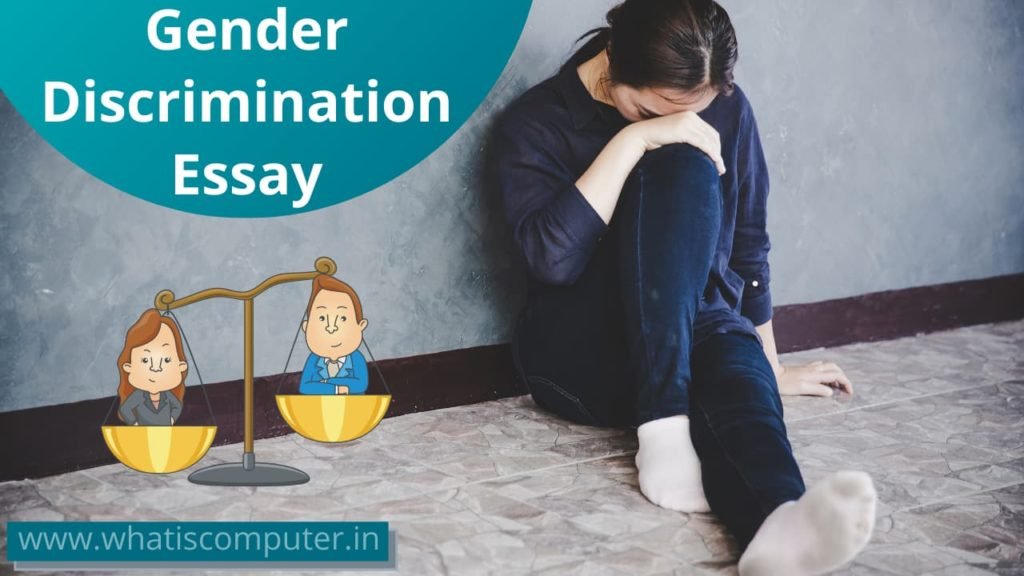Gender Discrimination Essay
Gender discrimination is defined as unequal treatment U on the basis of gender or sex, which leads to disparate opportunities. In India, girls and women are majorly affected by many social evils which shows disparities in educational qualifications, political influence, employment opportunities, salaries and wages, etc. They are perceived to be disadvantaged both at work and home.

It has prevailed in the Indian subcontinent since ages and people are still suffering from it although the Constitution of India has granted equal rights for both men and women. Every individual has the right to be treated equally on the basis of gender, caste, creed and religion as per the fundamental human rights mentioned in the constitution.
Female infanticide and sex-selective abortion is practiced in India and majorly reflects the low status of Indian women. Census 2011 witnessed a sharp decline in the girl population (as a percentage to total population) under the age of seven and the 2005 census showed that the infant mortality estimates for females and males are 61 and 56, respectively, out of 1000 live births, with girls more likely to be aborted than boys due to biased behavioural patterns among people.
Sons are preferred over daughters as they are thought to become heirs of the ancestral property and take the name ahead. Even wealthy and literate families followed the practice.
Education is yet another parameter of gender inequality that prevails in India. Most of the parents don’t send their daughters for higher education since they believe that they are only meant for household chores and investing in their career or education would not pay them anything in return.
Literacy for females stands at 65.46%, compared to 82.14% for males. Expected years of schooling for women is 11.3 and for men is 11.8 approximately and the ratio to males in primary and secondary education is 0.98 – 1.0
Not only this, considering the aspect of female employment opportunities, they are unfairly paid in comparison to males for the same work. According to a research, Indian women earn 64% of what their male counterparts earn for the same occupation and the level of qualification on an average. During 2005-06, Workforce Participation Rate of women was about 31% in rural areas and 14% in urban areas. On the other hand, for males, the WPR was about 56% both in rural areas and in urban areas.
Also, the discrimination is majorly seen in the health sector as well, the process of child-bearing exposes women to specific health care and associated risks. As per the SRS based researches, MMR had declined from 301 per one lakh live births to 254 per one lakh live births during 2004-06.
The government of India has taken various initiatives in order to empower women and grant them equal status as men. Enactment of laws like Criminal Amendment Act, 2013, the Protection of Women from Domestic Violence Act, 2005; Dowry Prohibition Act, 1961;Indecent Representation of Women (Prohibition) Act, 1986; the Sexual Harassment of Women at Workplace (Prevention, Prohibition and Redressal) Act, 2013, the Prohibition of Child Marriage Act, 2006 (PCMA), Equal Remuneration Act, 1976, Maternity Benefit Act, 1961 and 73rd – 74th Amendmentofthe Constitution mandating 33% reservation for women in the local governance are a few examples. It also organises campaigns for creating awareness about the problem and for educating parents about the issue.
Gender equality will only be reached if we are able to empower men, Michelle Bachelet
Women and girls have always been considered as a liability to the family, they are only meant to do the household chores and support raising of children. The Age specific mortality rate (ASMR) in year 2000 was observed to be 8.9 and has come down to 6.8 in the year 2008. But, today the scenario has changed, women support their families financially as well.
Girls have surpassed boys in a lot of fields ranging from education to employment. Thus, there is an underlying need for the parents and Indian society as a whole to understand the need of equality on the basis in order to have their daughters like Kalpana Chawla, Kiran Bedi, Indra Nooyi etc. much competent to sons.
Gender Discrimination Essay
ALSO READ: